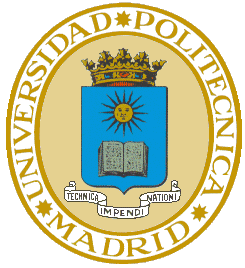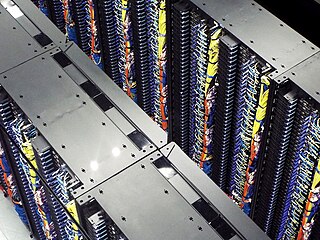
A supercomputer is a computer with a high level of performance compared to a general-purpose computer. The performance of a supercomputer is commonly measured in floating-point operations per second (FLOPS) instead of million instructions per second (MIPS). Since 2017, there are supercomputers which can perform up to nearly a hundred quadrillion FLOPS. Since November 2017, all of the world's fastest 500 supercomputers run Linux-based operating systems. Additional research is being conducted in China, the United States, the European Union, Taiwan and Japan to build even faster, more powerful and more technologically superior exascale supercomputers.
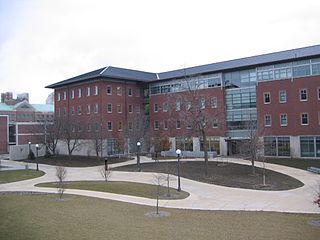
The National Center for Supercomputing Applications (NCSA) is a state-federal partnership to develop and deploy national-scale cyberinfrastructure that advances research, science and engineering based in the United States of America. NCSA operates as a unit of the University of Illinois at Urbana–Champaign, and provides high-performance computing resources to researchers across the country. Support for NCSA comes from the National Science Foundation, the state of Illinois, the University of Illinois, business and industry partners, and other federal agencies.
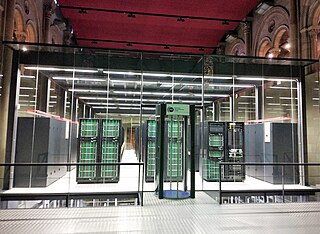
The Barcelona Supercomputing Center - Centro Nacional de Supercomputación is a public research center located in Barcelona, Catalonia, Spain. It hosts MareNostrum, a 13.7 Petaflops, Intel Xeon Platinum-based supercomputer, which also includes clusters of emerging technologies. In June 2017, it ranked 13th in the world.

The NASA Advanced Supercomputing (NAS) Division is located at NASA Ames Research Center, Moffett Field in the heart of Silicon Valley in Mountain View, California. It has been the major supercomputing and modeling and simulation resource for NASA missions in aerodynamics, space exploration, studies in weather patterns and ocean currents, and space shuttle and aircraft design and development for over thirty years.
The Blue Brain, a Swiss national brain initiative, aims to create a digital reconstruction of the brain by reverse-engineering mammalian brain circuitry. The mission of the project, founded in May 2005 by the Brain and Mind Institute of the École Polytechnique Fédérale de Lausanne (EPFL) in Switzerland, is to use biologically-detailed digital reconstructions and simulations of the mammalian brain to identify the fundamental principles of brain structure and function in health and disease.
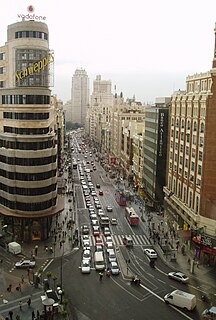
Centro is the central district of the city of Madrid, Spain. It is approximately 5.23 km² in size. It has a population of 149,718 people and a population density of 28,587/km².
The Texas Advanced Computing Center (TACC) at the University of Texas at Austin, United States, is an advanced computing research center that provides comprehensive advanced computing resources and support services to researchers in Texas and across the USA. The mission of TACC is to enable discoveries that advance science and society through the application of advanced computing technologies. Specializing in high performance computing, scientific visualization, data analysis & storage systems, software, research & development and portal interfaces, TACC deploys and operates advanced computational infrastructure to enable computational research activities of faculty, staff, and students of UT Austin. TACC also provides consulting, technical documentation, and training to support researchers who use these resources. TACC staff members conduct research and development in applications and algorithms, computing systems design/architecture, and programming tools and environments.
DGSCA, a.k.a. Computo Academico UNAM, previously known as PUC. It is the leading organization within the UNAM for computer technologies systems and held the distinction for being the first institution in México to install and operate a Cray Y-MP super computer, in early 1990.
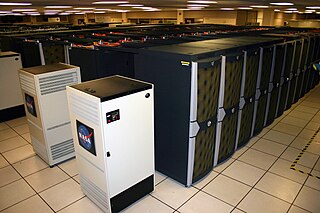
Pleiades is a petascale supercomputer housed at the NASA Advanced Supercomputing (NAS) facility at NASA Ames Research Center located at Moffett Field near Mountain View, California. It is maintained by NASA and partners Silicon Graphics (SGI) and Intel.

The Distributed European Infrastructure for Supercomputing Applications (DEISA) was a European Union supercomputer project. A consortium of eleven national supercomputing centres from seven European countries promoted pan-European research on European high-performance computing systems. By extending the European collaborative environment in the area of supercomputing, DEISA followed suggestions of the European Strategy Forum on Research Infrastructures.
SuperMUC is a supercomputer of the Leibniz Supercomputing Centre (LRZ) of the Bavarian Academy of Sciences. It is housed in the LRZ's data centre in Garching near Munich.

Japan operates a number of centers for supercomputing which hold world records in speed, with the K computer becoming the world's fastest in June 2011.

Several centers for supercomputing exist across Europe, and distributed access to them is coordinated by European initiatives to facilitate high-performance computing. One such initiative, the HPC Europa project, fits within the Distributed European Infrastructure for Supercomputing Applications (DEISA), which was formed in 2002 as a consortium of eleven supercomputing centers from seven European countries. Operating within the CORDIS framework, HPC Europa aims to provide access to supercomputers across Europe.
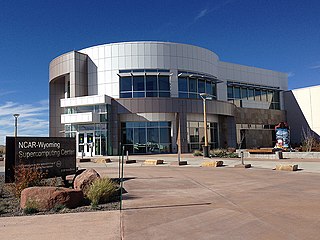
The NCAR-Wyoming Supercomputing Center (NWSC) is a high-performance computing (HPC) and data archival facility located in Cheyenne, Wyoming that provides advanced computing services to researchers in the Earth system sciences.

Galileo is a 1.1 petaFLOPS supercomputer located in Cineca.
Piz Daint is a supercomputer in the Swiss National Supercomputing Centre, named after the mountain Piz Daint in the Swiss Alps.
The Cray XC50 is a massively parallel multiprocessor supercomputer manufactured by Cray. The machine can support Intel Xeon processors, as well as Cavium ThunderX2 processors, Xeon Phi processors and NVIDIA Tesla P100 GPUs. The processor are connected by Cray's proprietary "Aries" interconnect, in a dragonfly network topology. The XC50 is an evolution of the XC40, with the main difference being the support of Tesla P100 processors.


